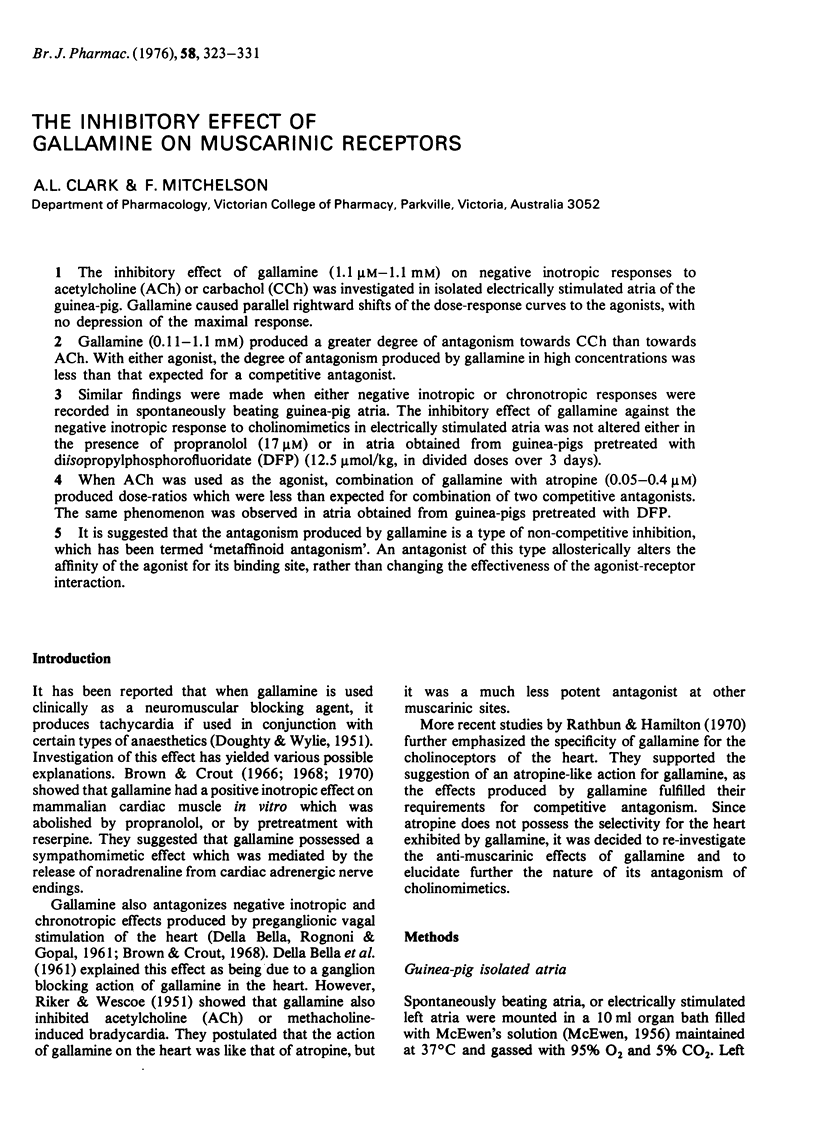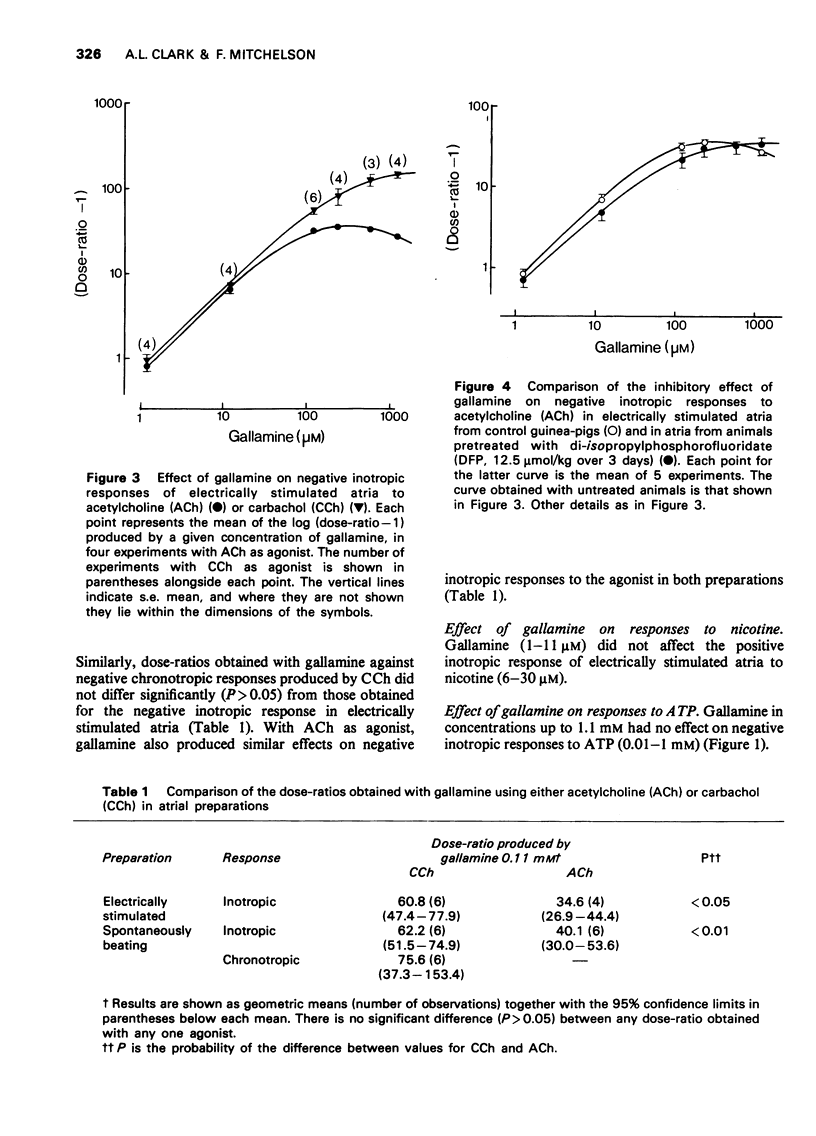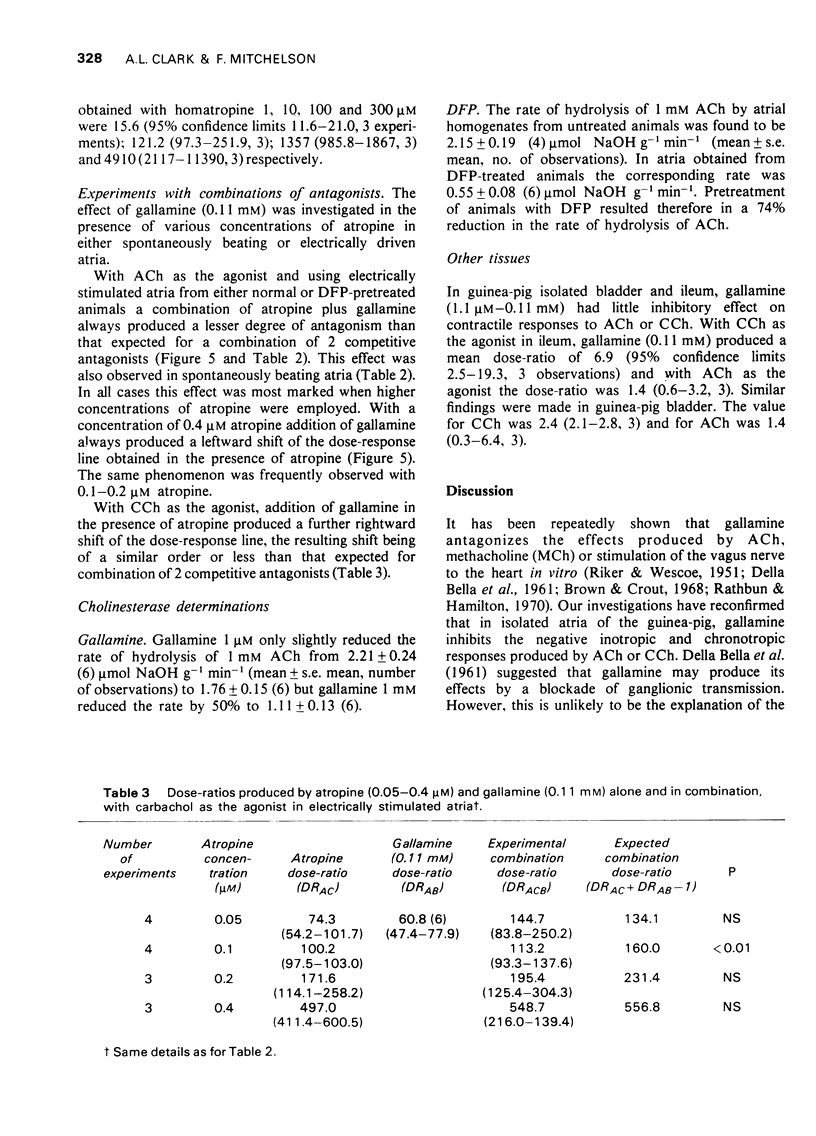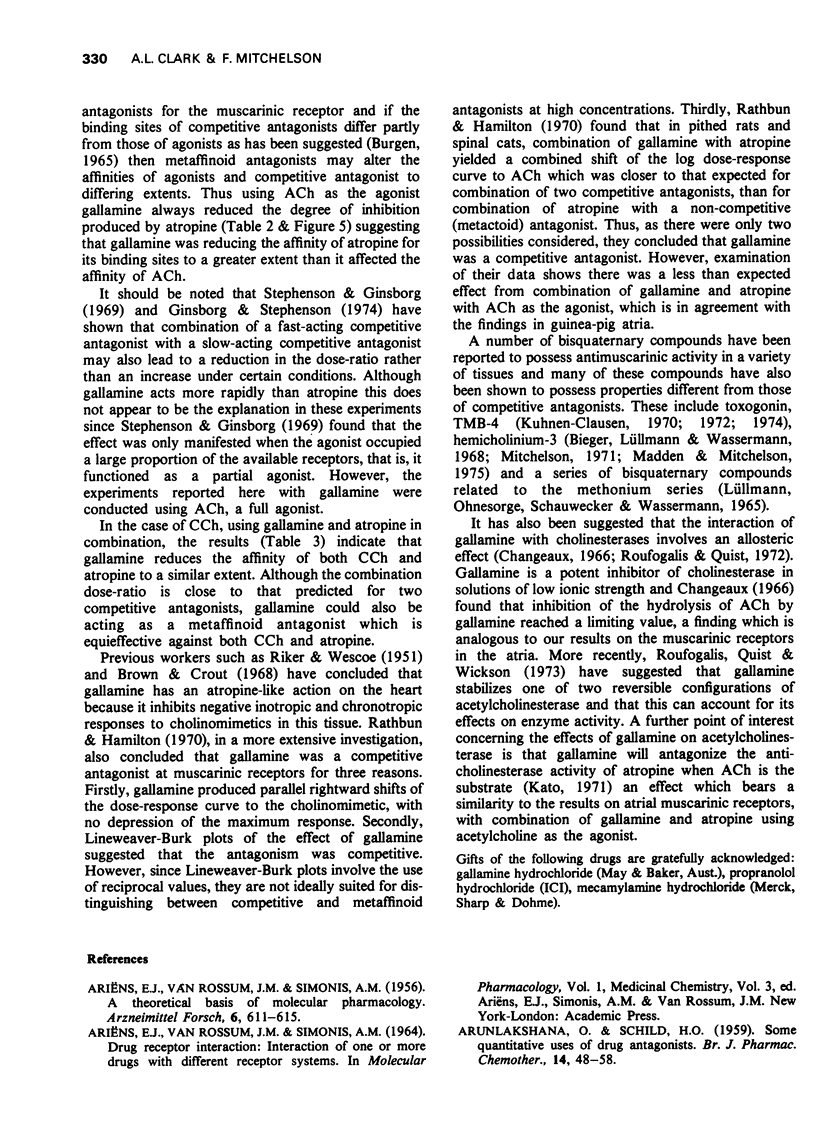Abstract
1 The inhibitory effect of gallamine (1.1 muM-1.1 mM) on negative inotropic responses to acetylcholine (ACh) or carbachol (CCh) was investigated in isolated electrically stimulated atria of the guinea-pig. Gallamine caused parallel rightward shifts of the dose-response curves to the agonists, with no depression of the maximal response. 2 Gallamine (0.11 - 1.1 mM) produced a greater degree of antagnism towards CCh than towards ACh. With either agonist, the degree of antagonism produced by gallamine in high concentrations was less than that expected for a competitive antagonist.. 3 Similar findings were made when either negative inotropic or chronotropic responses were recorded in spontaneously beating guinea-pig atria. The inhibitory effect of gallamine against the negative inotropic response to cholinomimetics in electrically stimulated atria was not altered either in the presence of propranol (17 muM) or in atria obtained from guinea-pigs pretreated with diisopropylphosphorofluoridate (DEP) 12.5 mumol/kg, in divided doses over 3 days). 4 When ACh was used as the agonist, combination of gallamine with atropine (0.05-0.4 muM) produced dose-ratios which were less than expected for combination of two competitive antagonists. The same phenomenon was observed in atria obtained from guinea-pigs pretreated with DFP. 5 It is suggested that the antagonism produced by gallamine is a type of non-competitive inhibition, which has been termed "metaffinoid antagonism". An antagonist of this type allosterically alters the affinity of the agonist for its binding site, rather than changing the effectiveness of the agonist-receptor interaction.
Full text
PDF








Selected References
These references are in PubMed. This may not be the complete list of references from this article.
- ARIENS E. J., SIMONIS A. M., VAN ROSSUM J. M. A theoretical basis of molecular pharmacology; II. Interactions of one or two compounds with two interdependent receptor systems. Arzneimittelforschung. 1956 Oct;6(10):611–621. [PubMed] [Google Scholar]
- ARUNLAKSHANA O., SCHILD H. O. Some quantitative uses of drug antagonists. Br J Pharmacol Chemother. 1959 Mar;14(1):48–58. doi: 10.1111/j.1476-5381.1959.tb00928.x. [DOI] [PMC free article] [PubMed] [Google Scholar]
- Barnett A., Benforado J. M. The nicotinic effects of choline esters and of nicotine in guinea pig atria. J Pharmacol Exp Ther. 1966 Apr;152(1):29–36. [PubMed] [Google Scholar]
- Bieger D., Lüllmann H., Wassermann O. Uber eine akute Anti-Acetylcholin-Wirkung von Hemicholinium No. 3 am Vorhof des Meerschweinchens. Naunyn Schmiedebergs Arch Exp Pathol Pharmakol. 1968;259(5):386–393. [PubMed] [Google Scholar]
- Brown B. R., Jr, Crout J. R. The sympathomimetic effect of gallamine on the heart. J Pharmacol Exp Ther. 1970 Apr;172(2):266–273. [PubMed] [Google Scholar]
- Changeux J. P. Responses of acetylcholinesterase from Torpedo marmorata to salts and curarizing drugs. Mol Pharmacol. 1966 Sep;2(5):369–392. [PubMed] [Google Scholar]
- Clark A. L., Mitchelson F. The effect of 4-(1-naphthylvinyl)-pyridine (NVP), a choline acetylase inhibitor, on autonomically innervated tissues of the rat. Eur J Pharmacol. 1974 Jun;27(1):34–39. doi: 10.1016/0014-2999(74)90199-x. [DOI] [PubMed] [Google Scholar]
- DOUGHTY A. G., WYLIE W. D. An assessment of flaxedil (Gallamine triethiodide, B.P.). Proc R Soc Med. 1951 May;44(5):375–388. doi: 10.1177/003591575104400509. [DOI] [PMC free article] [PubMed] [Google Scholar]
- Gingsborg B. L., Stephenson R. P. On the simultaneous action of two competitive antagonists. Br J Pharmacol. 1974 Jun;51(2):287–300. doi: 10.1111/j.1476-5381.1974.tb09659.x. [DOI] [PMC free article] [PubMed] [Google Scholar]
- KOCH-WESER J., BLINKS J. R. THE INFLUENCE OF THE INTERVAL BETWEEN BEATS ON MYOCARDIAL CONTRACTILITY. Pharmacol Rev. 1963 Sep;15:601–652. [PubMed] [Google Scholar]
- Kato G. Acetylcholinesterase. I. A study by nuclear magnetic resonance of the binding of inhibitors to the enzyme. Mol Pharmacol. 1972 Sep;8(5):575–581. [PubMed] [Google Scholar]
- Kuhnen-Clausen D. A novel approach to the questions of allosteric properties or a 'receptor reserve' of drug binding sites of intestinal smooth muscle cells. FEBS Lett. 1974 Feb 1;39(1):61–66. doi: 10.1016/0014-5793(74)80017-7. [DOI] [PubMed] [Google Scholar]
- Kuhnen-Clausen D. Investigations on the parasympatholytic effect of toxogonin on the guinea-pig isolated ileum. Eur J Pharmacol. 1970 Jan;9(1):85–92. doi: 10.1016/0014-2999(70)90324-9. [DOI] [PubMed] [Google Scholar]
- Kuhnen-Clausen D. Structure-activity relationship of mono- and bisquaternary pyridines in regard to their parasympatholytic effects. Toxicol Appl Pharmacol. 1972 Nov;23(3):443–454. doi: 10.1016/0041-008x(72)90046-4. [DOI] [PubMed] [Google Scholar]
- Löffelholz K. Autoinhibition of nicotinic release of noradrenaline from postganglionic sympathetic nerves. Naunyn Schmiedebergs Arch Pharmakol. 1970;267(1):49–63. doi: 10.1007/BF00997114. [DOI] [PubMed] [Google Scholar]
- Lüllmann H., Ohnesorge F. K., Schauwecker G. C., Wassermann O. Inhibition of the actions of carbachol and DFP on guinea pig isolated atria by alkane-bis-ammonium compounds. Eur J Pharmacol. 1969;6(3):241–247. doi: 10.1016/0014-2999(69)90181-2. [DOI] [PubMed] [Google Scholar]
- MCEWEN L. M. The effect on the isolated rabbit heart of vagal stimulation and its modification by cocaine, hexamethonium and ouabain. J Physiol. 1956 Mar 28;131(3):678–689. doi: 10.1113/jphysiol.1956.sp005493. [DOI] [PMC free article] [PubMed] [Google Scholar]
- Madden J., Mitchelson F. The interaction of hemicholinium-3 (HC-3) with cholinomimetics and atropine. Eur J Pharmacol. 1975 May;32(1):17–29. doi: 10.1016/0014-2999(75)90318-0. [DOI] [PubMed] [Google Scholar]
- Mitchelson F. Differentiation between the actions of acetylcholine and tetramethylammonium on the isolated taenia of the guinea-pig caecum by hemicholinium-3. Br J Pharmacol. 1971 May;42(1):43–55. doi: 10.1111/j.1476-5381.1971.tb07085.x. [DOI] [PMC free article] [PubMed] [Google Scholar]
- Offermeier J., van den Brink F. G. The antagonism between cholinomimetic agonists and beta-adrenoceptor stimulants. The differentiation between functional and metaffinoid antagonism. Eur J Pharmacol. 1974 Jul;27(2):206–213. doi: 10.1016/0014-2999(74)90147-2. [DOI] [PubMed] [Google Scholar]
- PATON W. D., RANG H. P. THE UPTAKE OF ATROPINE AND RELATED DRUGS BY INTESTINAL SMOOTH MUSCLE OF THE GUINEA-PIG IN RELATION TO ACETYLCHOLINE RECEPTORS. Proc R Soc Lond B Biol Sci. 1965 Aug 24;163:1–44. doi: 10.1098/rspb.1965.0058. [DOI] [PubMed] [Google Scholar]
- RIKER W. F., Jr, WESCOE W. C. The pharmacology of Flaxedil, with observations on certain analogs. Ann N Y Acad Sci. 1951 Oct;54(3):373–394. doi: 10.1111/j.1749-6632.1951.tb39932.x. [DOI] [PubMed] [Google Scholar]
- Rathbun F. J., Hamilton J. T. Effect of gallamine on cholinergic receptors. Can Anaesth Soc J. 1970 Nov;17(6):574–590. doi: 10.1007/BF03004717. [DOI] [PubMed] [Google Scholar]
- Roufogalis B. D., Quist E. E. Relative binding sites of pharmacologically active ligands on bovine erythrocyte acetylcholinesterase. Mol Pharmacol. 1972 Jan;8(1):41–49. [PubMed] [Google Scholar]
- Roufogalis B. D., Quist E. E., Wickson V. M. Effect of ligands on a discontinuous temperature dependence of the decarbamylation reaction of erythrocyte acetylcholinesterase. Biochim Biophys Acta. 1973 Oct 10;321(2):536–545. doi: 10.1016/0005-2744(73)90196-4. [DOI] [PubMed] [Google Scholar]
- Stephenson R. P., Ginsborg B. L. Potentiation by an antagonist. Nature. 1969 May 24;222(5195):790–791. doi: 10.1038/222790a0. [DOI] [PubMed] [Google Scholar]
- TODRICK A. The inhibition of cholinesterases by antagonists of acetylcholine and histamine. Br J Pharmacol Chemother. 1954 Mar;9(1):76–83. doi: 10.1111/j.1476-5381.1954.tb00820.x. [DOI] [PMC free article] [PubMed] [Google Scholar]


